Givaudan Bundle
How Did Givaudan Rise to Become a Global Sensation?
Delve into the captivating Givaudan SWOT Analysis to uncover the secrets behind a fragrance and flavor empire. From its humble beginnings in the late 18th century, Givaudan's journey is a testament to innovation, resilience, and strategic foresight. Discover how this Swiss company transformed from a small perfume factory into the world's largest player in the flavor and fragrance industry.
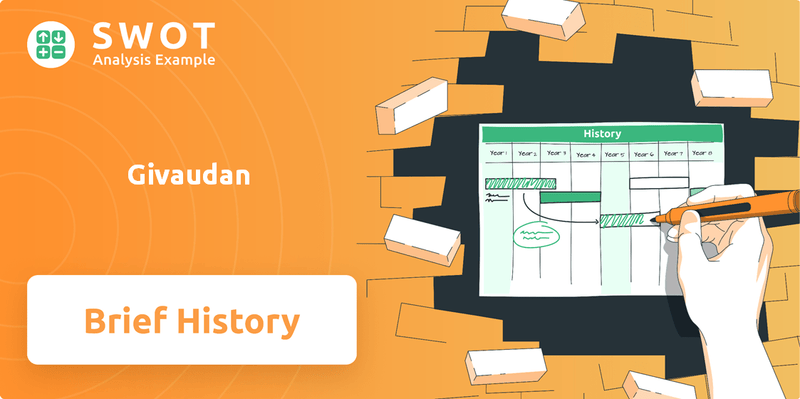
Givaudan's story is a fascinating exploration of the fragrance industry and flavor industry evolution. The brief history of Givaudan reveals key milestones, from its early years as a pioneer in synthetic fragrances to its current global presence. Understanding Givaudan's origins and its impact on the industry provides valuable insights for investors and business strategists alike.
What is the Givaudan Founding Story?
The origins of the Givaudan company trace back to 1895, when brothers Leon and Xavier Givaudan established the company in Zurich, Switzerland. This marked the formal beginning of what would become a global leader in the fragrance and flavor industry. The company's early focus on synthetic perfume ingredients set it apart, especially considering the prevalent use of natural, time-consuming extraction methods at the time.
Xavier Givaudan, with his background in chemistry and pharmacy, was instrumental in the company's formation. His education at the École de La Martinière and the Joint Faculty of Medicine and Pharmacy of Lyon provided a strong foundation for the company's early endeavors. This expertise was crucial in developing and producing synthetic ingredients that would revolutionize the fragrance industry.
In 1898, Givaudan relocated its operations from Zurich to Vernier, near Geneva, Switzerland. This move was prompted by a complaint from a local bakery, highlighting the potent nature of perfume production. This relocation established the company's global headquarters in Vernier, where it remains today. The company's initial funding likely came from the founders themselves or private investments, given the rapid establishment and factory construction. The late 19th century's economic landscape, with Switzerland as a hub for the chemical industry, provided a favorable environment for Givaudan's growth.
Givaudan was founded in 1895 by Leon and Xavier Givaudan in Zurich, Switzerland, focusing on synthetic perfume ingredients.
- Xavier Givaudan's background in chemistry was key to the company's early success.
- The company relocated to Vernier, near Geneva, in 1898, where its headquarters remain.
- Switzerland's burgeoning chemical industry in the late 19th century fostered Givaudan's growth.
Givaudan SWOT Analysis
- Complete SWOT Breakdown
- Fully Customizable
- Editable in Excel & Word
- Professional Formatting
- Investor-Ready Format
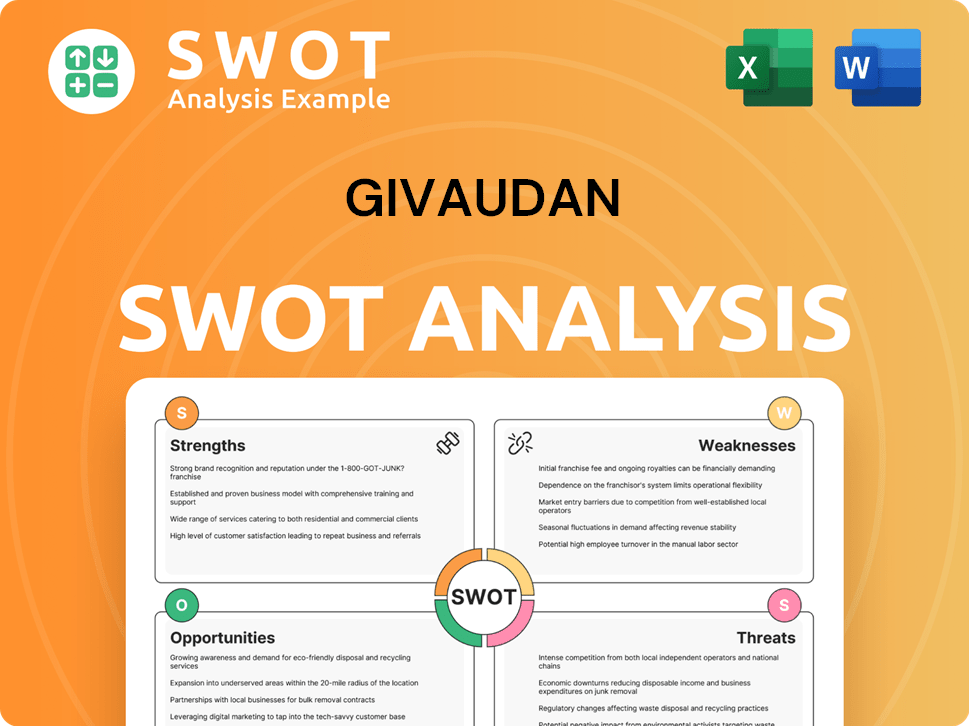
What Drove the Early Growth of Givaudan?
The early growth of the Givaudan company was marked by strategic expansions and diversification within the fragrance and flavor industries. This Swiss company significantly increased its global footprint, establishing key operations and making strategic acquisitions. These moves helped shape the Givaudan history and its position as a leader in the market.
In 1917, Givaudan established its first U.S. operations in New York, followed by a facility in Clifton, New Jersey, in 1924. This marked the beginning of its presence in the North American market. These early investments were crucial for the company's growth and its ability to serve a wider customer base within the fragrance industry.
A pivotal moment in Givaudan's evolution came in 1948 with the acquisition of Esrolko SA, a producer of synthetic flavorings near Zurich. This acquisition was a key step in establishing the two main pillars of its business: flavors and fragrances. This strategic move expanded Givaudan's product portfolio and market reach within the flavor industry.
Givaudan opened factories in the UK and Brazil in 1950, and in Spain in 1960, further solidifying its global presence. A major shift occurred in 1963 when the pharmaceutical giant Roche acquired Givaudan. Roche's acquisition of Roure in 1964, a competitor with historical roots in Grasse, complemented Givaudan's strengths.
The merger of Givaudan and Roure in 1991 formed Givaudan-Roure. Acquisitions like Fritzsche, Dodge and Olcott in 1991, and Tastemaker in 1997, made Givaudan the largest flavor company. In 2000, Roche spun off Givaudan-Roure, and it was listed on the Swiss Stock Exchange as Givaudan SA. For more insights, check out the Marketing Strategy of Givaudan.
Givaudan PESTLE Analysis
- Covers All 6 PESTLE Categories
- No Research Needed – Save Hours of Work
- Built by Experts, Trusted by Consultants
- Instant Download, Ready to Use
- 100% Editable, Fully Customizable
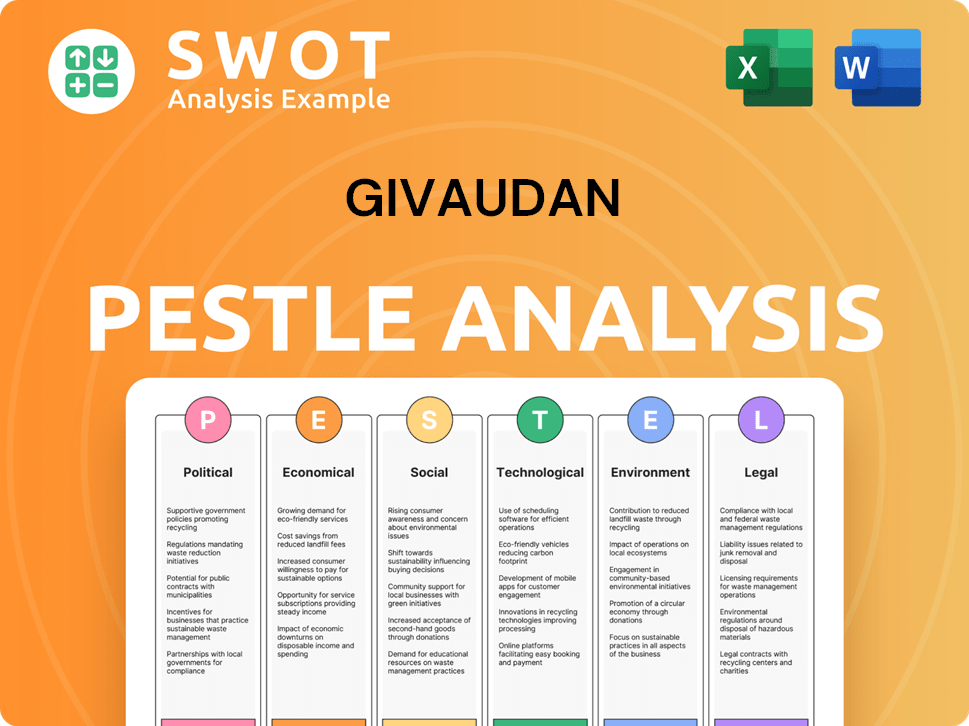
What are the key Milestones in Givaudan history?
The Givaudan company has a rich history marked by significant achievements and strategic expansions within the fragrance and flavor industry. From its early years to its current global presence, Givaudan has consistently demonstrated a commitment to innovation and growth, shaping its position as a leader in the Swiss company landscape.
| Year | Milestone |
|---|---|
| 1946 | Opened its perfumery school, training a significant portion of the world's creative perfumers. |
| 1976 | Experienced an environmental crisis due to an accident at its Icmesa plant in Seveso, Italy. |
| 1996 | Developed ScentTrek, a technology capturing the chemical makeup of smells from living plants. |
| 1999 | Launched TasteTrek, a similar technology for flavors. |
| 2007 | Acquired Quest International, expanding its global reach and market position. |
| 2024 | Introduced PrimalHyal™ 50 Life, a hyaluronic acid produced using strain engineering and precision fermentation. |
Givaudan's innovations have been pivotal in the fragrance and flavor industry, with technologies like ScentTrek and TasteTrek revolutionizing how scents and flavors are captured and replicated. These advancements have not only set new industry standards but also enhanced Givaudan's product development capabilities, solidifying its competitive edge.
ScentTrek, introduced in 1996, is a groundbreaking technology that captures the chemical composition of scents from living plants. This innovation earned the company the Fragrance Foundation's first Fifi Innovation Technology of the Year Award.
TasteTrek, launched in 1999, mirrors ScentTrek's approach but focuses on flavors, allowing for the analysis and replication of complex tastes. This technology has been crucial in flavor industry advancements.
In 2024, Givaudan introduced PrimalHyal™ 50 Life, a hyaluronic acid produced using strain engineering and precision fermentation. This innovation significantly reduces greenhouse gas emissions.
Givaudan's perfumery school, established in 1946, has trained a substantial portion of the world's creative perfumers. This commitment underscores the company's dedication to talent development within the fragrance industry.
The acquisition of Quest International in 2007 marked a significant expansion of Givaudan's global presence. This strategic move strengthened its position as a leader in both flavors and fragrances.
Givaudan is focusing on sustainable ingredients and partnerships with startups and research institutions. This approach drives innovation in areas like plant-based proteins, aligning with market trends and sustainability goals.
Throughout its history, Givaudan has faced challenges, including environmental crises and market downturns. The company has responded to these issues through strategic acquisitions and a strong focus on innovation, ensuring its continued growth and relevance in the flavor industry and fragrance industry.
The 1976 accident at the Icmesa plant, a Givaudan subsidiary, resulted in dioxin contamination, creating a significant environmental and public health crisis. This event highlighted the importance of stringent safety measures.
Givaudan has strategically responded to market downturns by focusing on organic growth and strategic partnerships. This approach has helped improve its bottom line and maintain its market share.
The company has addressed competitive threats through strategic acquisitions and a strong emphasis on innovation. This strategy has enabled Givaudan to stay ahead in the dynamic fragrance and flavor industry.
Givaudan has made significant strides in sustainability, reducing its Scope 1 and 2 emissions by 48% compared to a 2015 baseline. They also met their 2025 target of converting their entire electricity supply to fully renewable sources in 2024.
Maintaining a high pace of innovation in the face of evolving consumer preferences and technological advancements is a constant challenge. Givaudan addresses this through continuous research and development.
Global supply chain disruptions can impact the availability of raw materials and production costs. Givaudan mitigates these risks through diversified sourcing and robust supply chain management.
Givaudan Business Model Canvas
- Complete 9-Block Business Model Canvas
- Effortlessly Communicate Your Business Strategy
- Investor-Ready BMC Format
- 100% Editable and Customizable
- Clear and Structured Layout
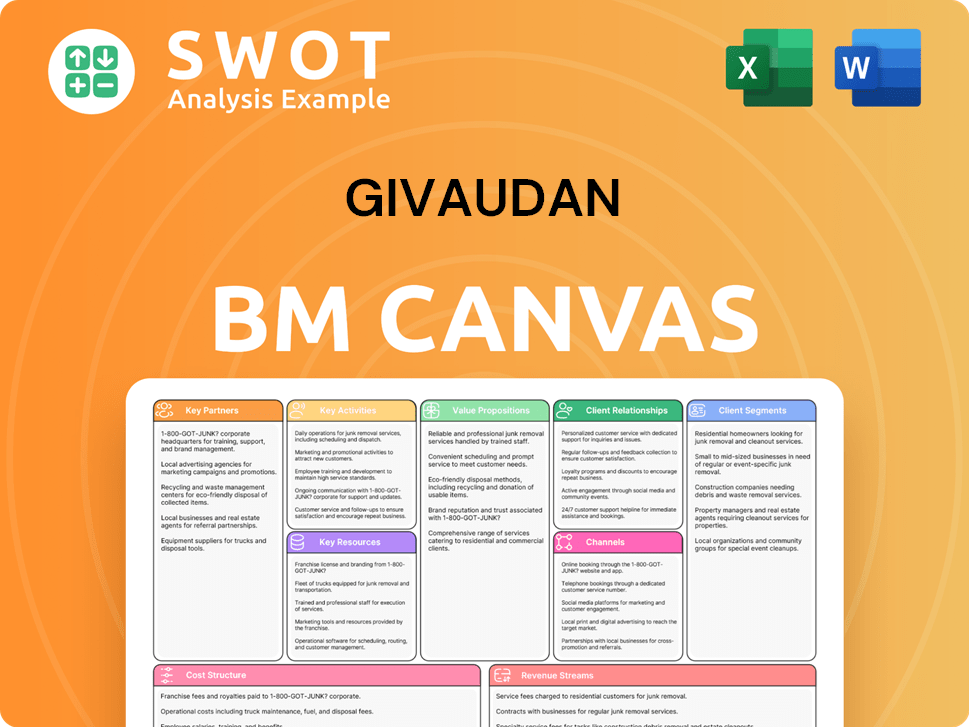
What is the Timeline of Key Events for Givaudan?
The Givaudan company has a rich history, evolving from its roots in the fragrance industry to become a global leader in flavors and fragrances. Key milestones highlight its growth and adaptation over centuries.
| Year | Key Event |
|---|---|
| 1768 | Antoine Chiris establishes a perfumery in Grasse, France, a foundational element of Givaudan's heritage. |
| 1796 | American firm Dodge & Olcott begins importing essential oils, later becoming part of Givaudan. |
| 1895 | Leon and Xavier Givaudan found Givaudan & Cie in Zurich, Switzerland, marking the official start of the Givaudan company. |
| 1898 | Givaudan relocates its headquarters to Vernier, Switzerland. |
| 1946 | Givaudan opens its perfumery school. |
| 1948 | Givaudan acquires Esrolko SA, entering the flavor industry. |
| 1963 | Givaudan is acquired by Roche. |
| 1991 | Givaudan and Roure merge to form Givaudan-Roure. |
| 1997 | Givaudan-Roure acquires Tastemaker, becoming the largest flavor company globally. |
| 2000 | Givaudan-Roure is spun off by Roche and listed on the Swiss Stock Exchange as Givaudan SA. |
| 2007 | Givaudan acquires Quest International. |
| 2014 | Givaudan enters the Active Beauty business with the acquisition of Soliance. |
| 2024 | Givaudan reports full-year revenue of CHF 7.412 billion, an increase of 12.3% on a like-for-like basis from 2023. |
| 2024 | Givaudan acquires b.kolormake-up, expanding into the makeup category. |
| 2024 | Givaudan meets its 2025 target of converting its entire electricity supply to fully renewable sources. |
Givaudan's 2025 strategy, 'Committed to Growth, with Purpose,' is focused on sustainable value creation. This involves a strong emphasis on creations, nature, people, and communities. The company aims to drive continued innovation and expansion across its diverse portfolio.
Givaudan aims to exceed its 4-5% average annual sales growth target for 2021-2025, having achieved an average like-for-like sales growth of 7.2% for the period 2021-2024. The company forecasts earnings growth of 6.2% and revenue growth of 4.4% per annum. This reflects a positive outlook for the Swiss company.
Strategic initiatives include expansion into nutrition, food ingredients, and beauty markets. The company is also focusing on maximizing opportunities in mature markets while extending its leadership in high-growth markets. The focus is on product development and innovation within the fragrance industry and flavor industry.
Givaudan plans to be climate positive before 2050, with interim goals of reducing Scope 1 and 2 emissions by 70% and Scope 3 emissions by 20% by 2030. The company aims to be rated among the leading employers for inclusion globally before 2025 and to have 50% of its senior leaders be women by 2030. These efforts highlight Givaudan's commitment to sustainability.
Givaudan Porter's Five Forces Analysis
- Covers All 5 Competitive Forces in Detail
- Structured for Consultants, Students, and Founders
- 100% Editable in Microsoft Word & Excel
- Instant Digital Download – Use Immediately
- Compatible with Mac & PC – Fully Unlocked
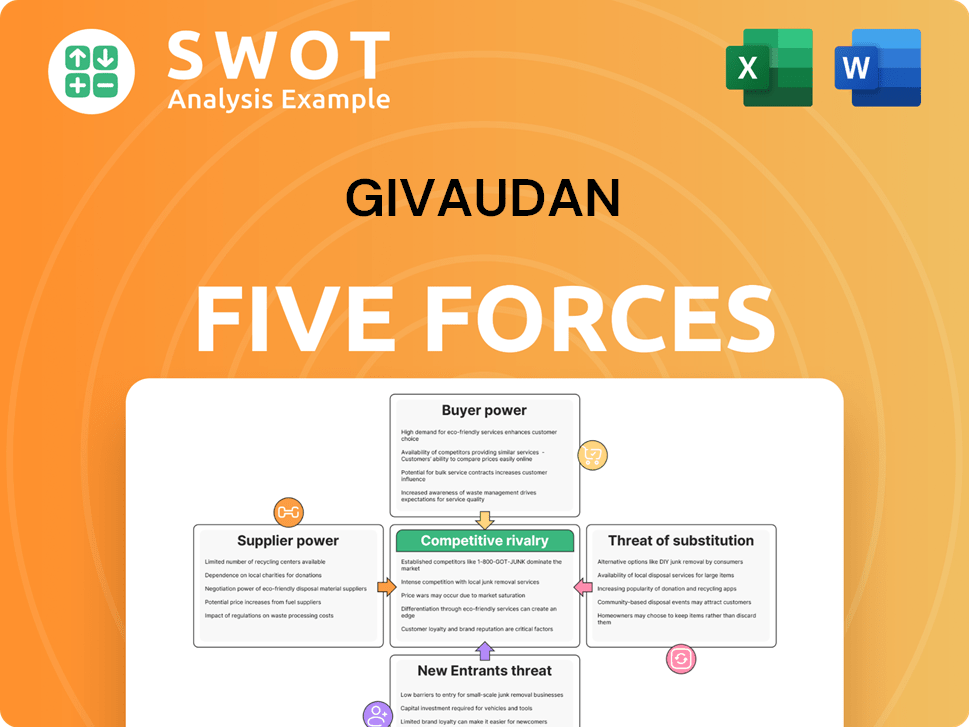
Related Blogs
- What is Competitive Landscape of Givaudan Company?
- What is Growth Strategy and Future Prospects of Givaudan Company?
- How Does Givaudan Company Work?
- What is Sales and Marketing Strategy of Givaudan Company?
- What is Brief History of Givaudan Company?
- Who Owns Givaudan Company?
- What is Customer Demographics and Target Market of Givaudan Company?
Disclaimer
All information, articles, and product details provided on this website are for general informational and educational purposes only. We do not claim any ownership over, nor do we intend to infringe upon, any trademarks, copyrights, logos, brand names, or other intellectual property mentioned or depicted on this site. Such intellectual property remains the property of its respective owners, and any references here are made solely for identification or informational purposes, without implying any affiliation, endorsement, or partnership.
We make no representations or warranties, express or implied, regarding the accuracy, completeness, or suitability of any content or products presented. Nothing on this website should be construed as legal, tax, investment, financial, medical, or other professional advice. In addition, no part of this site—including articles or product references—constitutes a solicitation, recommendation, endorsement, advertisement, or offer to buy or sell any securities, franchises, or other financial instruments, particularly in jurisdictions where such activity would be unlawful.
All content is of a general nature and may not address the specific circumstances of any individual or entity. It is not a substitute for professional advice or services. Any actions you take based on the information provided here are strictly at your own risk. You accept full responsibility for any decisions or outcomes arising from your use of this website and agree to release us from any liability in connection with your use of, or reliance upon, the content or products found herein.